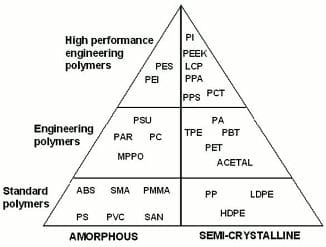When it comes to outdoor applications, ABS can have issues with exposure to UV light and with heat ageing. But what can be done? Dr Charlie Geddes investigates in this blog article, written for Hardie […]
When we see ‘FR‘ in a plastics grade coding, we can sometimes be lulled into believing we have a material that is ‘fire resistant.’
Polymers with amide links have been around for some time but the close cousins, the imide links, are less well known.
In the early days, plastics moulders tended to apply descriptive terms to moulding faults, but these terms do not accurately indicate the root cause.
Falling weight impact tests can yield much more relevant information than single-point impact testing; however, they come with their own challenges.
Cracking of plastics components under impact was a major blow to the plastics industry in the early days. Today it is still a challenge for designers to select thermoplastics that will stand up to impact […]
Low-cost identification of plastics is certainly desirable, but identifying an unknown plastic material can be an expensive exercise if you submit it for full chemical analysis.
Radiation in the ultraviolet region of the spectrum is a bit of a mixed blessing for polymers.
When faced with selecting a thermoplastic for a new component, I find it helpful to view potential materials in two groups …. amorphous (non-crystalline) and crystalline (strictly speaking semi-crystalline because it is unusual to get […]
To assess solvent resistance, first consider solvents spread out on a polarity scale. Non-polar solvents are at one end, such as paraffin, petrol and diesel. At the other ‘highly polar’ end we find alcohols and […]









